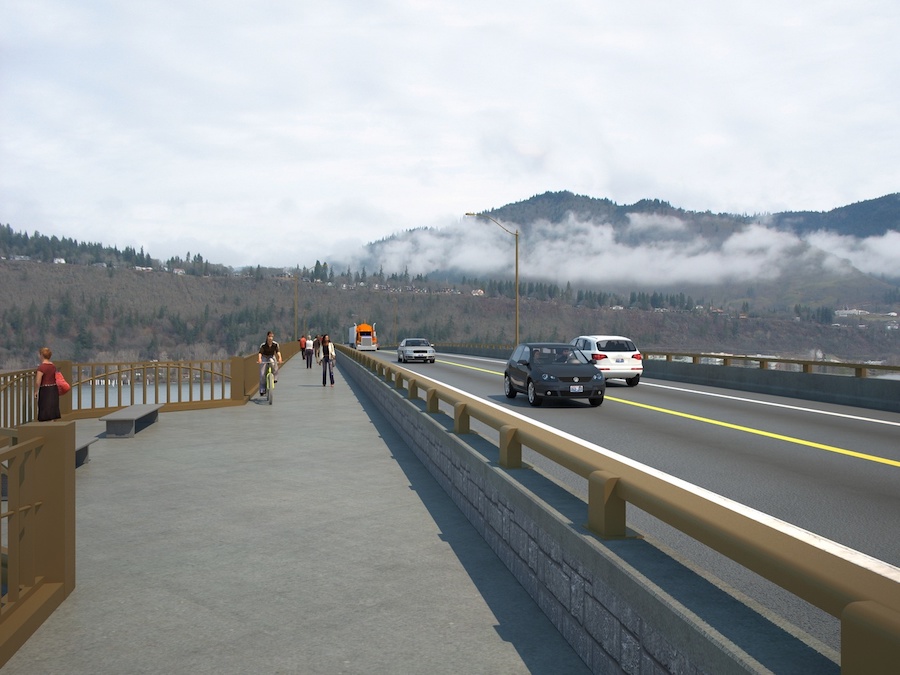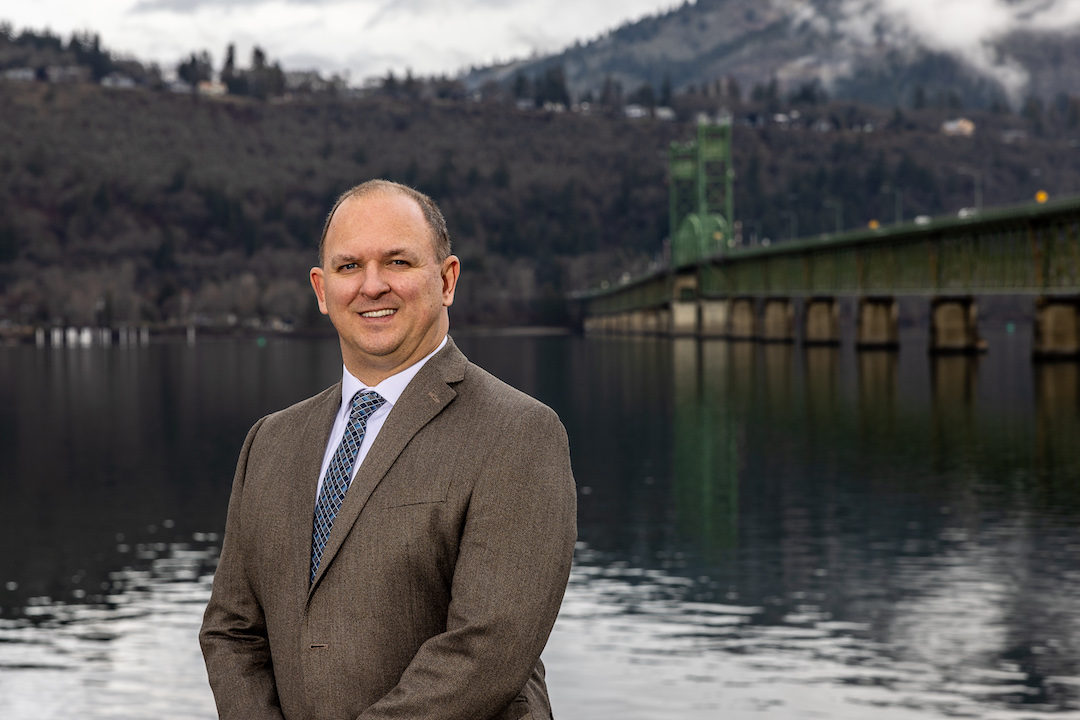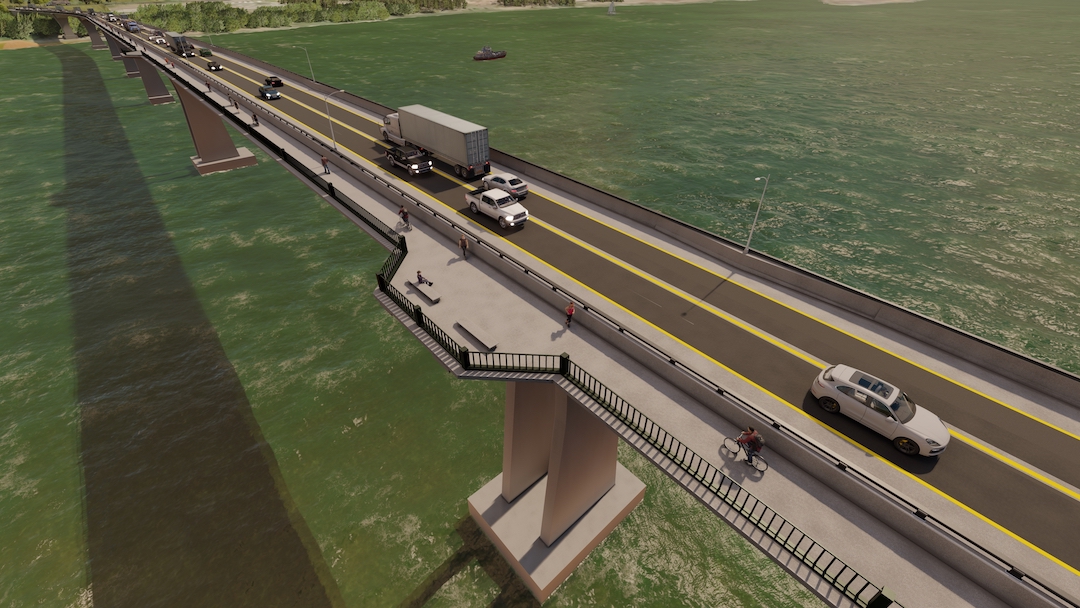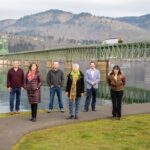Brand Story – Port of Hood River and bistate group secures funding, hires project management firm and kicks off preliminary engineering for bridge replacement.
Five years ago, the Port of Hood River and its partners in Klickitat County, WA, picked up the baton and began leading the long, multilayered process of securing a new interstate bridge for the Mid-Columbia River region. Now in the preliminary engineering phase, the project shows no signs of slowing as it moves closer to its goal: replacing the obsolete, 100-year-old bridge with one equipped to support the Columbia River Gorge’s economic future.
The team has been busy applying for funding, hiring a project management team, passing legislation for a bistate bridge authority, finalizing its National Environmental Protection Act (NEPA) application, engaging in talks with tribes, commissioning surveys and studies, solidifying a project delivery method and launching geotechnical borings.
A bistate working group—composed of the mayors of Hood River, White Salmon and Bingen, county commissioners from Klickitat and Hood River and the Port of Hood River Commission—oversees these many diverse components.
 The proposed span accommodates pedestrians and bikes.
The proposed span accommodates pedestrians and bikes.
“I think the bistate collaboration on this project has gone so smoothly because we understand the critical role this bridge plays in the long-term viability of our communities,” says Marla Keethler, Mayor of White Salmon.
While still heavily involved in day-to-day tasks, the working group will give way to a new bistate bridge authority in July 2023. In the same spirit of the working group, the bridge authority will provide a permanent voice to both sides of the Gorge. Since 1950, the bridge has been owned by the Port and operated by the Port of Hood River Commission, which is comprised of only Oregon residents.
“This new agency will have three Oregon members and three Washington members, and they will be the decision makers for the replacement effort,” explains Kevin Greenwood, Executive Director, Port of Hood River. “Once the bridge is up and running, they will be the policy-setting board, determining the tolls and how it will be managed. At that point, the Port of Hood River will be essentially out of the bridge business.”
 Kevin Greenwood, Port Executive Director
Kevin Greenwood, Port Executive Director
Due to the expense demanded by a project of this size—roughly $500 million, based upon a December 2021 preliminary cost estimate—its success hinges on funding from both Washington and Oregon. Thanks to initial funding, including a $5-million BUILD grant, $10 million from Oregon and $81.5 million earmarked by Washington Senator Curtis King, the bistate working group hired infrastructure solutions firm HNTB Corporation as the technical project management team.
“That’s a huge milestone because once we brought HNTB on board the project lurched forward,” Greenwood recalls. “They’ll be doing the geotechnical work, facilitating and supporting policy advisory meetings, leading our lobbying efforts in D.C., Olympia and Salem, developing requests for proposals, and designing procurement processes for financing, engineering and construction contracts.”
HNTB began by determining a project delivery method, ultimately selecting a progressive design build approach, which involves hiring a contractor who then selects the designer with whom they want to collaborate.
“Our main goal is managing risk. If there’s risk of something unknown, we can get information and work through solutions,” explains Michael Shannon, Project Director, HNTB Corporation. “The problem with design build is that it’s not collaborative, so any bidding package will need to have a certain amount of risk priced in.”
 Michael Shannon, HNTB project manager.
Michael Shannon, HNTB project manager.
Progressive design build avoids that problem. More collaboration decreases unknowns, decreasing costs. Importantly, this approach also lets the project commence without all of its funding in hand.
As part of the preliminary engineering phase, the team has commenced geotechnical borings around the pier, marking the first step visible to the public. With the resulting data on soil conditions, future contractors can exclude unknown soil risks from their pricing, thereby cutting overall cost.
According to Shannon, the project’s complexity stems mainly from its unique location.
 Rendering of replacement bridge.
Rendering of replacement bridge.
“It’s a pretty straightforward bridge, but what makes it complex is the working environment the bridge will be in,” he explains. “Weather in the Gorge is extreme. We have to have a contractor used to working in these conditions. You’ve also got thousands of people playing in the water with a major construction project happening next door, so the safety aspect will be very complex.”
Furthermore, seasonal fish migrations define the work windows in which construction can occur, so contractors will have to plan and execute carefully to maximize those opportunities or wait until the next year.
“Working with different states and parties and opinions has not been the challenging part because everyone agrees that this bridge has to be replaced to meet the current needs of the area,” Shannon adds. “Everyone is in alignment with what it needs to be.”
The aging bridge has become prohibitively costly to maintain while falling short of the region’s economic needs, including inadequate weight limits, narrow lanes with no shoulder and a substandard maritime navigational channel. The deck’s metal grate allows fluids and material to fall from vehicles directly into the water. There are seismic concerns, too.
 current bridge
current bridge
The list of inadequacies with the current bridge is long, but so is the list of benefits a new structure would bring, such as pedestrian and bike lanes to support commuters and connect tourists with the Historic Columbia River Highway.
With a weight limit increase from 80,000 to 105,500 pounds, the new bridge will link the critical Washington and Oregon regional and interstate freight corridors, easily accommodating trucks carrying heavy loads, like logs or gravel. This could increase truck usage by 15 percent.
For now, funding remains the team’s priority and the project’s main barrier. As they move forward on all fronts, they will continue championing the project’s importance to appropriators in Washington, Oregon, and Washington D.C.
“I hope this project paves the way for future collaborations not just in the Gorge region but other bistate efforts on the Washington-Oregon state lines,” Keethler concludes. “I think what we are showing in this effort is that when the interests and long-term resiliency of our communities are prioritized, there is the ability to find common ground and unite residents and leaders around a shared vision for the future.
Brand stories are paid content articles that allow Oregon Business advertisers to share news about their organizations and engage with readers on business and public policy issues. The stories are produced in house by the Oregon Business marketing department. For more information, contact associate publisher Courtney Kutzman.



